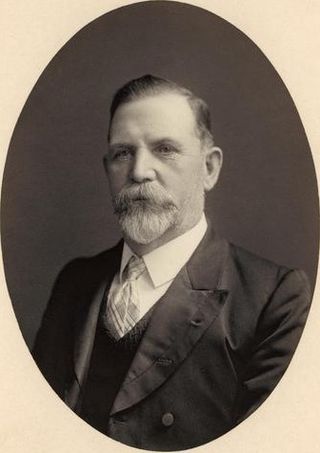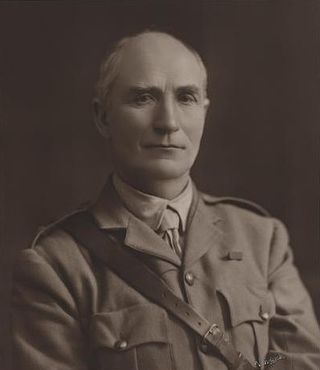Related Research Articles
The Free Trade Party, officially known as the Free Trade and Liberal Association, and also referred to as the Revenue Tariff Party in some states, was an Australian political party, formally organised in 1887 in New South Wales, in time for the 1887 New South Wales colonial election, which the party won.
The Protectionist Party, also known as the Protectionist Liberal Party or Liberal Protectionist Party, was an Australian political party, formally organised from 1887 until 1909, with policies centred on protectionism. The party advocated protective tariffs, arguing it would allow Australian industry to grow and provide employment. It had its greatest strength in Victoria and in the rural areas of New South Wales. Its most prominent leaders were Sir Edmund Barton and Alfred Deakin, who were the first and second prime ministers of Australia.
The Liberal Party was a parliamentary party in Australian federal politics between 1909 and 1917. The party was founded under Alfred Deakin's leadership as a merger of the Protectionist Party and Anti-Socialist Party, an event known as the Fusion.
This is a list of the members of the Australian House of Representatives in the Third Australian Parliament, which was elected on 12 December 1906.

The 1906 Australian federal election was held in Australia on 12 December 1906. All 75 seats in the House of Representatives, and 18 of the 36 seats in the Senate were up for election. The incumbent Protectionist Party minority government led by Prime Minister Alfred Deakin retained government, despite winning the fewest House of Representatives votes and seats of the three parties. Parliamentary support was provided by the Labour Party led by Chris Watson, while the Anti-Socialist Party, led by George Reid, remained in opposition.

The 1910 Australian federal election was held in Australia on 13 April 1910. All 75 seats in the House of Representatives, and 18 of the 36 seats in the Senate were up for election. The incumbent Liberal Party led by Prime Minister Alfred Deakin was defeated by the opposition Australian Labor Party (ALP) led by Andrew Fisher.
This article provides information on candidates who stood for the 1903 Australian federal election. The election was held on 16 December 1903.
This article provides information on candidates who stood for the 1906 Australian federal election. The election was held on 12 December 1906.
This article provides information on candidates who stood for the 1913 Australian federal election. The election was held on 31 May 1913.
This article provides information on candidates who stood for the 1917 Australian federal election. The election was held on 5 May 1917.
This article provides information on candidates who stood for the 1922 Australian federal election. The election was held on 16 December 1922.
This article provides information on candidates who stood for the 1925 Australian federal election. The election was held on 14 November 1925.

William Russell was a Scottish-born Australian politician. He was a liberal member of the South Australian Legislative Council from 1895 to 1900 and an Australian Labor Party member of the South Australian House of Assembly (Burra) (1901-1902) and the Australian Senate (1906-1912).

Joseph Vardon was an Australian politician. He served as a Senator for South Australia in 1907 and from 1908 to 1913. He was also a member of the South Australian Legislative Council from 1900 to 1906.

James Vincent O'Loghlin was an Australian politician.
This is a list of members of the Australian Senate from 1910 to 1913. Half of its members were elected at the 12 December 1906 election and had terms starting on 1 January 1907 and finishing on 30 June 1913—they had an extended term as a result of the 1906 referendum, which changed Senate terms to finish on 30 December, rather than 30 June—the other half were elected at the 13 April 1910 election and had terms starting on 1 July 1910 and finishing on 30 June 1916. Parties reflect those acknowledged at the time of the 1910 election.
This is a list of members of the Australian Senate from 1907 to 1910. Half of its members were elected at the 16 December 1903 election and had terms starting on 1 January 1904 and finishing on 30 June 1910; the other half were elected at the 12 December 1906 election and had terms starting on 1 January 1907 and finishing on 30 June 1913. They had an extended term as a result of the 1906 referendum, which changed Senate terms to finish on 30 June, rather than 31 December.

Blundell v Vardon, was the first of three decisions of the High Court of Australia concerning the 1906 election for senators for South Australia. Sitting as the Court of Disputed Returns, Barton J held that the election of Anti-Socialist Party candidate Joseph Vardon as the third senator for South Australia was void due to irregularities in the way the returning officers marked some votes. The Parliament of South Australia appointed James O'Loghlin. Vardon sought to have the High Court compel the governor of South Australia to hold a supplementary election, however the High Court held in R v Governor of South Australia; Ex parte Vardon that it had no power to do so. Vardon then petitioned the Senate seeking to remove O'Loghlin and rather than decide the issue, the Senate referred the matter to the High Court. The High Court held in Vardon v O'Loghlin that O'Loghlin had been invalidly appointed and ordered a supplementary election. Vardon and O'Loghlin both contested the supplementary election, with Vardon winning with 54% of the vote.
This is a list of electoral results for the Australian Senate in South Australia since Federation in 1901.